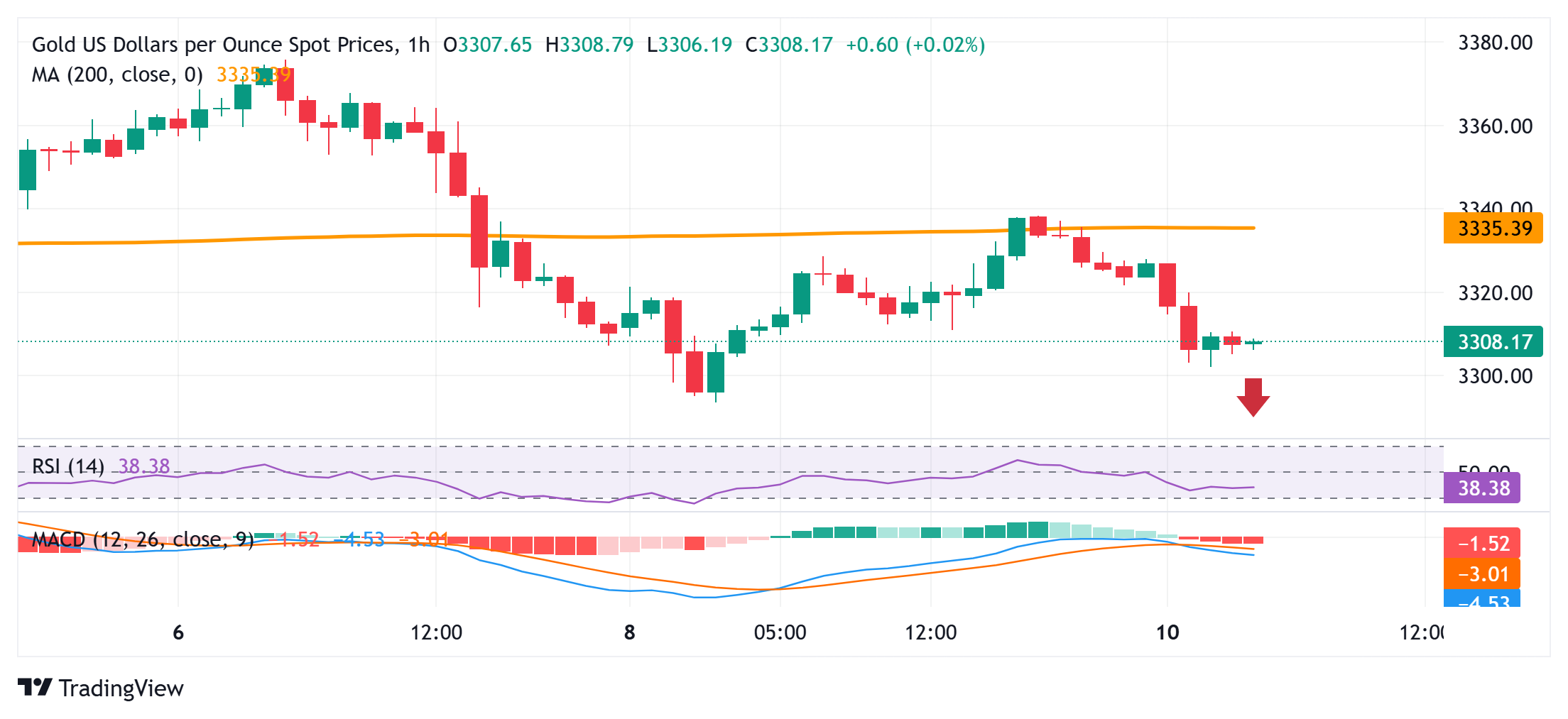- Gold price attracts some dip-buyers on Tuesday, though the uptick lacks bullish conviction.
- Fed rate cut bets, US fiscal concerns, and geopolitical risks lend support to the commodity.
- The emergence of some USD buying and trade optimism cap gains for the XAU/USD pair.
Gold price (XAU/USD) rebounds from the vicinity of the $3,300 mark and trades with modest intraday losses heading into the European session on Tuesday. Investors remain on edge as US-China trade talks extend for a second day in London, which, along with persistent geopolitical risks, act as a tailwind for the safe-haven bullion. Apart from this, bets that the Federal Reserve (Fed) will cut interest rates further in 2025 turn out to be another factor lending support to the non-yielding yellow metal.
Meanwhile, the US Dollar (USD) struggles to capitalize on the intraday move higher and remains confined in a familiar range close to its lowest level since April 22 amid concerns about the worsening US fiscal situation. This further benefits the Gold price and contributes to the intraday recovery. Traders, however, seem reluctant and might opt to wait for US consumer inflation figures, warranting caution before positioning for an extension of the XAU/USD pair’s overnight bounce from a one-week low.
Daily Digest Market Movers: Gold price attracts safe-haven flows amid nervousness ahead of US-China trade talks
- Chinese and US officials extend the new round of trade talks in London to a second day on Tuesday, fueling hopes for a deal between the world’s two largest economies. This remains supportive of a generally positive risk tone and prompts fresh selling around the safe-haven Gold price during the Asian session on Tuesday.
- A stronger-than-expected US Nonfarm Payrolls (NFP) report released on Friday dampened hopes for imminent interest rate cuts by the Federal Reserve this year. This assists the US Dollar to regain positive traction and turns out to be another factor that contributes to driving flows away from the non-yielding yellow metal.
- However, the CME Group’s FedWatch Tool indicates that traders are still pricing in a nearly 60% chance that the US central bank will cut interest rates at its September monetary policy meeting. This, along with concerns about the US government’s financial health, fails to assist the USD to capitalize on its intraday move higher.
- On the geopolitical front, Russia launched a massive airstrike on Ukraine and fired nearly 500 drones and missiles. This marks a further escalation of the conflict in the three-year-old war and might hold back the XAU/USD bears from placing aggressive bets in the absence of any relevant market-moving economic data from the US.
- The US Consumer Price Index (CPI) and the Producer Price Index (PPI) are due for release on Wednesday and Thursday, respectively. The crucial inflation figures should provide some cues about the Fed’s future rate-cut path, which, in turn, will drive the USD demand and provide some meaningful impetus to the commodity.
Gold price is likely to face stiff resistance and remain capped near the $3,352-3,353 region

From a technical perspective, the overnight failure to find acceptance above the 200-hour Simple Moving Average (SMA) and the subsequent slide favors the XAU/USD bears. Moreover, oscillators on hourly charts have been gaining negative traction and back the case for further intraday losses. Some follow-through selling below the $3,294-3,293 area, or the overnight swing low, will reaffirm the bearish outlook and make the Gold price vulnerable to accelerate the fall towards the $3,246-3,245 area (May 29 swing low) en route to the $3,200 neighborhood.
On the flip side, the 100-hour SMA, currently pegged near the $3,333-3.334 area might continue to act as an immediate hurdle. A sustained strength beyond could trigger an intraday short-covering move and lift the Gold price to the $3.352-3,353 hurdle. The momentum could extend further towards the $3,377-3,378 resistance, which if cleared should allow the XAU/USD to make a fresh attempt to conquer the $3,400 round figure.
US-China Trade War FAQs
Generally speaking, a trade war is an economic conflict between two or more countries due to extreme protectionism on one end. It implies the creation of trade barriers, such as tariffs, which result in counter-barriers, escalating import costs, and hence the cost of living.
An economic conflict between the United States (US) and China began early in 2018, when President Donald Trump set trade barriers on China, claiming unfair commercial practices and intellectual property theft from the Asian giant. China took retaliatory action, imposing tariffs on multiple US goods, such as automobiles and soybeans. Tensions escalated until the two countries signed the US-China Phase One trade deal in January 2020. The agreement required structural reforms and other changes to China’s economic and trade regime and pretended to restore stability and trust between the two nations. However, the Coronavirus pandemic took the focus out of the conflict. Yet, it is worth mentioning that President Joe Biden, who took office after Trump, kept tariffs in place and even added some additional levies.
The return of Donald Trump to the White House as the 47th US President has sparked a fresh wave of tensions between the two countries. During the 2024 election campaign, Trump pledged to impose 60% tariffs on China once he returned to office, which he did on January 20, 2025. With Trump back, the US-China trade war is meant to resume where it was left, with tit-for-tat policies affecting the global economic landscape amid disruptions in global supply chains, resulting in a reduction in spending, particularly investment, and directly feeding into the Consumer Price Index inflation.







